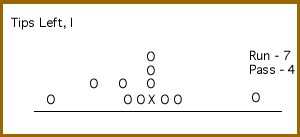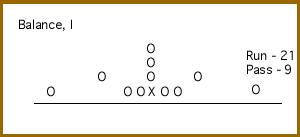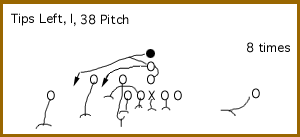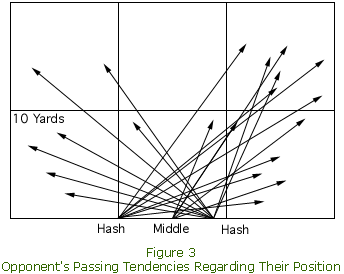Offensive Tendency Breakdown Sheet
The chart above is but one possible sort for the defensive coaches to get some idea of what the opponent is attempting to do on certain downs and distances, position on the field, and formations. One’s imagination is the only constraint for what information might be analyzed. The Defensive Coordinator then summarizes the information that he believes is important to prepare for the game on Saturday on a Scout Sheet. A partial example of the Scout Sheet is illustrated in figure 2.
This information is Xeroxed and passed out to all the defensive coaches and players and then discussed when they meet to watch the film of their upcoming opponent. Pass/run tendencies and the number of times they run certain plays versus the opponent’s formations are discussed. Some players at this time will also obtain a copy of the video and scout the player that they will play against.
As a secondary coach, one will look at the video and represent where the ball was thrown from its position on the field on a diagram. The coach is attempting to gain a greater understanding as to what the opponent’s passing tendencies are regarding their position on the field (see Figure 3)Scout Sheet # ___1__ Opponent: Bulldogs Date: Nov. 14/98
Information: First film — Lions vs. Bulldogs, Oct. 31/98
Number of Offensive Running Plays - 37 Passing Plays — 21
- Bulldogs are a run oriented team. They will try to get #8 to the outside. He tries to run the sideline and will cut it up if he sees a seam. We must keep our pursuit lanes and keep a green jersey in front of him he will then run to the sideline.
- We cannot put our focus on #8 as the fullback #32 is a good runner also. They counter him or dive him off the QB option.
- The option is a play to set up the tailback and the fullback. It is to our advantage if the QB runs.
- We must play tough TEAM defense with ATTITUDE and we will have a great chance.
Basic Formations


Running Plays


Scout Sheet

From this, the coach can ascertain that the Bulldogs have a tendency to throw to the strong or wide side of the field. Also, when they do go the other way, the ball was thrown to the closest receiver to the quarterback out of the Ace Right formation (see Figure 4).

Back Up Seam Pass from the Ace Right Formation
Also the secondary coach can represent the opponent’s pass plays with a diagram to check where the wide receivers line up widthwise (split) versus the pass play being run. For example, with a narrow split are the wide receivers running outside routes? With a wide split are they running inside routes? In preparation for this particular game, the secondary coach found a tendency from these diagrams that indicated that with a certain split one could expect an outside route. The first time the Bulldogs gave the secondary this read the player adjusted and the Bulldogs were unsuccessful. However, when another player was playing the same position later on in the game, he did not notice, and the Bulldogs had a long pass completion!
Practice
At practice, the Bulldog’s pass plays are represented on diagrams and shown to the scout team who then represent the opposition’s passing offense by acting out the plays against the defense. At any time the coaches can stop or repeat a play to help the defensive backs and/or linebackers understand what the opponent is trying to do and communicate how the team is going to defend a certain route. Tendencies from the Scout Sheet and the secondary coach’s diagrams are reviewed with the defensive backs at this time. After practice, these players are asked to use the Scout Sheet running and passing plays to mentally review their defensive assignments and reactions
From the computer analysis the Defensive Coordinator represents running and passing plays that are of concern to him and on what down and distance the defensive team might expect them on diagrams. The Defensive Coordinator also makes up his preliminary Defensive Ready Sheet of defenses he will use in certain situations in the game on Saturday (see Figure 5).